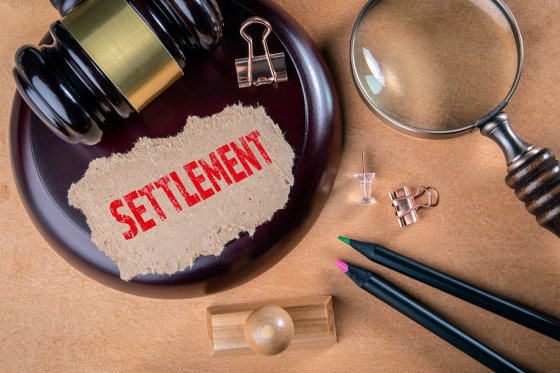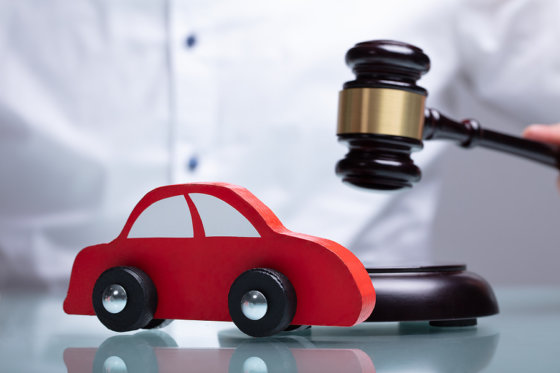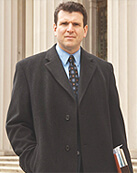When you think about car accident personal injury cases, you probably think either about making a simple insurance claim or engaging in a dramatic courtroom scene. The reality is that 95 percent of personal injury claims settle out of court. For those who do go to court, 57 percent favor the plaintiff (that is, the person filing the suit). This means that if you or a loved one has been in a New York car accident where you suffered injuries, the odds of you gaining a favorable settlement look surprisingly good. Our car accident lawyers break down everything you need to know about auto accident settlements.
Remember, however, that a car accident claim is not a lottery ticket.
You must prove that:
- The at-fault party or parties owed you a duty of care
- They breached that duty
- The breach resulted in an injury or death
- You suffered damages for which you seek monetary compensation
If your car accident attorney can persuade the at-fault parties that you are likely to prevail on the merits of your case and recover damages, the at-fault parties and their insurance companies are likely to enter into settlement negotiations. Even if your attorney already filed a lawsuit, your case can still settle before any trial date.
Why Do Insurance Companies Prefer to Settle?

Insurance companies prefer to settle rather than litigate because it gives them more control over the outcome of your case than they might in a jury trial. Negotiations between a skilled and experienced plaintiff’s lawyer and an insurance company lawyer do not usually feature the kind of emotional reaction that can occur in jury award decisions in some personal injury lawsuits.
Furthermore, litigation is not cheap. Whether in-house or outside counsel, lawyers cost significant sums for their time, and there are further expenses of gathering and producing admissible evidence and building a case strategy. Finally, the standard of proof in personal injury cases is proof by a preponderance of the evidence. This standard means that the plaintiff was at least mostly right about what happened. Looking at this numerically, this will be roughly a 51 percent standard, while the “beyond a reasonable doubt” standard applied in criminal law is more like 99.5 percent. In a car accident case, you will be attempting to prove that a preponderance of the evidence supported a finding that the at-fault parties were, in fact, negligent.
What Is Negligence in New York?
Proving negligence in New York involves proving four elements. The more likely the other parties’ attorneys think you can prove those elements, the more likely they are to settle favorably for you.
These elements are:
- A duty of care owed to you as a foreseeable victim - In New York, you must prove that someone owed you the standard of care that a reasonably prudent person should give you under similar circumstances. This is an objective standard applied to the person as found. In other words, a deaf defendant should act in the manner of a reasonably prudent deaf person.
- There are some exceptions to this standard.
- Professionals - licensed professionals owe a duty similar to that of an average member of that profession practicing in a similar community, e.g., an attorney licensed in New York will have the duty of care of an average New York attorney.
- Persons with Superior Knowledge - These individuals must comply with the standard of care of a reasonable person with that same superior knowledge.
- Children - Children under the age of four have no legal duty to anyone. Children over the age of four owe a duty of care to a hypothetical child of similar age, intelligence, and experience. The reasonable person standard can also apply to minors only if a child engages in conduct that can also be an adult activity. An adult activity is normally only allowed for adults, such as driving a car.
- If there was a duty, did the at-fault party breach it - You as the plaintiff must show that the at-fault party or parties not only owed a duty to you but that they breached that duty. Your attorney must clearly and expressly identify the negligent conduct. You cannot simply say that John Smith damaged me through negligent conduct. Instead, you must say that by failing to observe the speed limit and driving under the influence of alcohol, John Smith caused the car accident in which I suffered my injuries.
- Did the breach of duty cause the injury - The injured party must then show that the at-fault parties’ breach was both the actual and the proximate cause of the injuries.
- Actual Cause - Actual cause means, essentially, that “but for” the defendant’s conduct, the plaintiff would not suffer the injury. This standard directly connects the defendant’s conduct to the plaintiff’s injury.
- Proximate Cause - Proximate cause in New York focuses on whether it is legally appropriate to connect the breach to the injury. Most often, this analysis concentrates on whether the injuries were foreseeable results of the conduct. If, for example, a defendant hits the plaintiff with his car in such a manner that it injures the plaintiff’s spine, the later permanent paralysis suffered by the injured party is a foreseeable result of that injury.
- Is it legally fair for the plaintiff to receive damages as a remedy for the breach - The plaintiff must demonstrate that it is fair and equitable to receive a damage award from this defendant for the injuries and losses.
One of the more compelling reasons to work with a skilled and knowledgeable car accident attorney for your New York car accident is that he or she will have experience in establishing these required elements to insurance companies to such a degree of certainty that settlement becomes a more attractive option than the risks and costs of litigation. Proving negligence and establishing who was at fault is one of the many offerings a skilled attorney can assist you with?
What Damages Can I Recover?

Generally, you will recover all damages you can prove stemmed from the at-fault parties’ negligent conduct. These damages include:
- Economic Damages - Economic (or special) damages are those financial or out-of-pocket damages that you can prove by invoices, receipts, and similar records. They aim to make the plaintiff financially whole from the damages suffered. They can include:
- Medical and hospital costs
- Physical Therapy
- Assistive Equipment and Care
- In-Home Care
- Lost Wage
- Property Damage
- Non-Economic Damages - Non-economic (or general) damages are more subjective and less easily susceptible to quantification and proof. They can include:
- Future Medical Costs
- Futures Assistive Care Costs
- Rehabilitation
- Loss of Earning Capacity
- Loss of Enjoyment of Life
- Pain and Suffering
- Loss of Consortium
Injuries that can result in non-economic damages include:
- Bodily pain and physical and emotional discomfort
- Traumatic brain injuries
- Loss of function in any body part
- Loss of motor skills
- Loss of cognitive function
- Disfigurement of the body caused by burns, or scars, or amputations
- Reduction in life expectancy
- Long-lasting disability
- Complications in daily living
- Limitations in present physical ability or limitations likely to arise in the future
- Alteration in eating and sleeping patterns
- Post-traumatic stress disorder (PTSD)
- Mood swings or disorders
- Emotions of anger or fear
- Anxiety or depression
- Loss of enjoyment in activities that were previously enjoyable, such as sports or mental activities
Unlike many states, New York does not impose a cap on non-economic damages.
- Punitive Damages - Although rarely awarded, punitive damages may be available in New York, where the at-fault parties’ conduct was particularly egregious, extreme, or immoral. In other words, if the at-fault parties’ negligence, recklessness, or willful misconduct is so bad that it shocks the court, the court may award punitive damages. Punitive damages do not aim to make the injured party whole. Instead, the law intends for them to punish the at-fault parties and to deter others from engaging in similar conduct. New York does not impose a cap on punitive damages.
How Does Someone Receive a Settlement?
Not only is settling cheaper and less risky, but it is also faster and more subject to the control of the parties in reaching a given outcome. You can settle the process of negotiating with the other party. Once the parties agree, the parties enter into a written agreement outlining the agreed-upon terms.
The written agreement, signed by both parties, will usually contain:
- Terms of payment - The parties will agree on the damage value and how to pay them. Sometimes, for example, the payment may be a lump sum paid to the plaintiff. In other cases, when appropriate, someone may purchase an annuity to ensure that they receive timely payments for the remainder of the plaintiff’s life. Any arrangement for deferred payments or interest should also go in this section. The causes for which the damages are being paid should also be stated explicitly at this point in the agreement.
- Release of Claims - There should be a section in the agreement expressly releasing any claims that the plaintiff may have against the defendants with a statement that the release is in consideration of the damages paid.
- Choice of Law and Venue - The agreement will usually indicate whose law will apply to the settlement and where any resort to the courts must occur.
- Enforcement - If the parties have agreed on any forum for settling disputes about the agreement, they should include all relevant terms in the agreement.
- Signatures - All parties to the settlement must sign the agreement.
If the case was in litigation, the document will be a Stipulation of Settlement and you must file it with the court. If no litigation is in progress, the document is simply a Settlement Agreement.
Making Payments
If there is a simple lump-sum payment of the settlement, the settling party will issue a check or wire making the payment, usually from the defendant or the defendant’s insurance company. If there was an attorney, which is critical in obtaining a favorable settlement, the case was likely on a contingency fee basis, and the check or wire will be made payable to the attorney or law firm.
Upon receiving the funds, the attorney or law firm, under the terms of their agreement with the plaintiff, deducts fees and expenses from the award and forwards the balance to the plaintiff.
Sometimes, when a settlement involves very large sums or awards that should last for the plaintiff’s lifetime, they will set up an annuity for a structured settlement. The annuity will then make the required periodic payments to the plaintiff. Annuities can also exist without a structured settlement. To learn more about the general process of how much you will receive from your claim or how its paid out speaking with an experienced attorney can help answer some of those questions due to the experienced and legal expertise.
Taxation of Settlement Proceeds
Generally, the Internal Revenue Code exempts settlements from inclusion as taxable income. This exemption applies regardless of whether the settlement is paid as a lump sum or as periodic payments, including those under an annuity. Punitive damages, however, are usually taxable income.
Contact a Car Accident Attorney Today

As you’ve seen, even if a car accident case does not go to court, settling the case is not an easy job. Insurance company lawyers are aware of the time pressure and financial needs you are under, as well as the fact that your injuries have left you vulnerable and eager to settle soon. Instead of adding to your stress and worry, consider working with an experienced New York car accident attorney.
In most cases, working with an experienced attorney can increase your settlement amount. Insurers take advantage of unrepresented claimants, often pushing them to agree to a far too low settlement. Claimants who do not understand the process might mistakenly accept something that fails to cover even a fraction of their losses. By calling the right law firm, you can avoid this.
Contact an attorney today for a no-cost initial consultation and case evaluation. Let us help you receive the appropriate compensation for your injuries. Additional resources you may find helpfull for your claim also include how long your settlement will take and/or why you shouldn't accept the first settlement after your crash.



